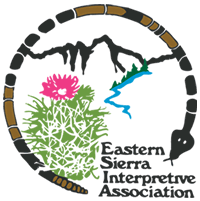Click the links below to learn more about the Alabama Hills
If you’ve visited the Alabama Hills, there is a good chance you enjoy the outdoors and love recreating outside. With nearly 100 years of recreational impacts in the Hills, from movie sets to climbing to camping and driving vehicles, this landscape has been highly influenced by humans.
With outdoor recreation comes the responsibility of stewardship- caring for the land. If we recreate in an area, it is our responsibility to take care of it and protect it from degradation so wildlife can thrive and future generations may enjoy it as well!
ESIA, in partnership with the BLM, the Alabama Hills Stewardship Group, and many other organizations regularly conducts restoration and revegetation work in the Alabama Hills. These activities typically focus on former campsites and routes that have been closed, newly disturbed areas caused by visitor use, wildfires, and flooding.
Over 100 different locations within the Hills have been restored. In the summer of 2022, the final step in implementing the Designated Camping portion of the management plan was complete. As of October 2022, camping has been condensed to over 50 designated campsites in the Alabama Hills (in addition to the several campgrounds that are available).
Original Stewards of the Land
The indigenous people of this Valley have resided here as their ancestors have for thousands of years. They still care for this area today.
Naturalizing former campsites and other disturbed areas
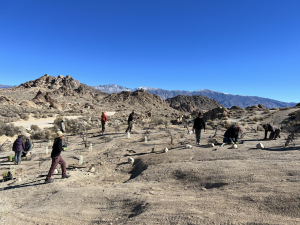
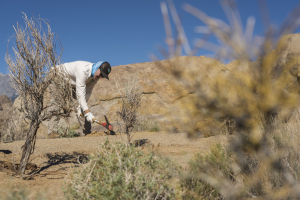
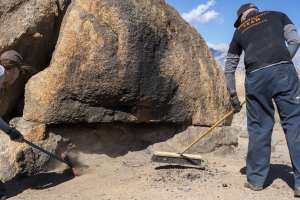
Planting Native Plants
Native plants help keep the ecosystem healthy by preserving biodiversity. They nurture and shelter the living landscape by providing food and habitat for animals. Revegetation work is done in the Alabama Hills in order to help re-establish native plants in the disturbed areas. In arid environments such as the Alabama Hills, the natural recovery of native plant communities may take decades. Re-establishing native vegetation helps stabilize soil, reduces the potential for weeds to colonize the area, and promotes natural ecological processes.
Most revegetation work in the Alabama Hills is done using native shrub and grass seedlings that are grown locally in a greenhouse from seeds collected in the Alabama Hills and surrounding area. The plants most used for revegetation in the Alabama Hills include allscale saltbush (Atriplex polycarpa) and desert needle grass (Stipa speciosa). Allscale saltbush is a scraggly-looking shrub that grows to about 3 feet high with inconspicuous flowers. It is common throughout much of the Movie Flat area.
Desert needlegrass is a perennial bunch of grass that grows interspersed among the shrubs but can often be found growing up against the base of rocks. In the spring and early summer when desert needlegrass is flowering, the short feathery hairs of the flower may appear to glow in the sunlight.
Although several other local species are also used for revegetation projects, allscale saltbush and desert needlegrass are the most frequently used due to them being common species in the area and their relatively good survivorship compared to the other species.
Planting Vertical Mulch
This is a restoration technique in which dead shrubs are planted into bare ground. These patches of vertical mulch are a natural technique to deter off-road vehicular and foot traffic, protect the fragile desert vegetation, and act as anchors to catch seeds and water which promote the growth of new plants. This technique has been widely used in the Alabama Hills.
Fire Ring Relocation and Removal
In the Alabama Hills National Scenic Area, fires are only permitted in existing campsites. Even though campers like to have fires under overhanging rocks, this leaves an unsightly black fire scar for years to come. We relocate fire rings into appropriate areas such as our Designated Campsites. Additionally, fire rings pop up in locations that are closed to camping. To dismantle the fire rings, we remove rocks and ash and adjust them to a more natural area.
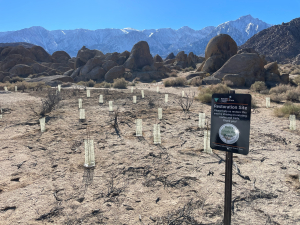
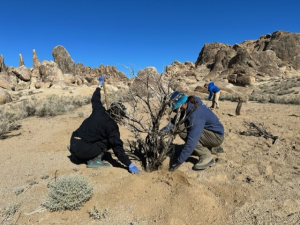
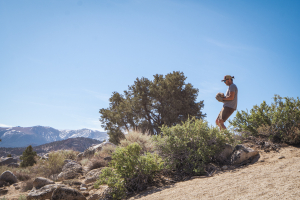
Graffiti Removal
Graffiti on natural surfaces, like rocks, are not appropriate and damage the scenic value of a natural area. Removing graffiti vandalism in the Hills can be a grueling and time-consuming process. Even small tagging can take hours of work, from hauling water and the necessary equipment to the time and elbow-grease spent removing it.
Brushing Off-Road Tire Tracks
Desert plants keep the soil healthy and provide homes and food for wildlife. They are specially adapted for this desert environment. Sagebrush is known to live up to 100 years! However, these plants can easily be destroyed if driven on by vehicles. When people see tire tracks going off designated trails and roads, they are more likely to follow these tracks. This can lead to roads and campsites expanding. By brushing out tire tracks, we keep vehicles on designated roads and trails.
Picking Up Trash
Picking up trash protects wildlife, plant life, waterways, soil, and ecosystems from being introduced to potentially harmful substances. It improves the scenic value of an area and creates a more pristine nature experience for others. And did you know that numerous psychological studies have proved that a place that is “trashed” is more likely to keep being trashed because this sets a low standard? Whereas litter-free places promote people to hold onto their trash and dispose of it properly.
How to get involved!
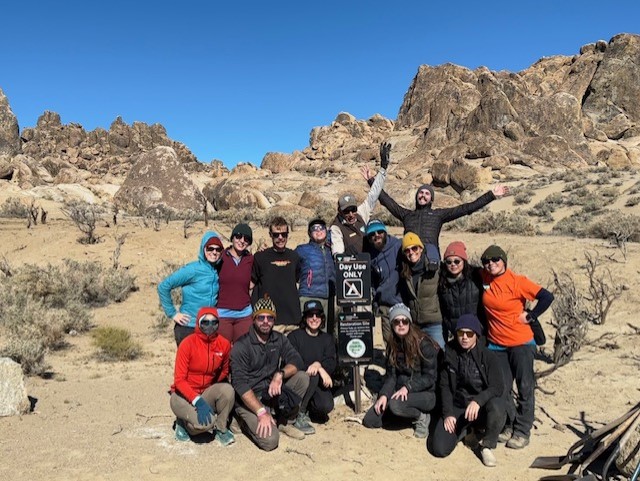
- Donate or become a member today! Our programs would not be here without your generous donations. Help provide tools, educational material, and interpretive programs.
- Alabama Hills Newsletter Sign up for our newsletter to keep up with what we are doing in the Hills!

